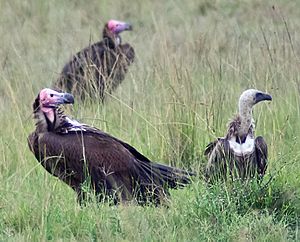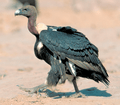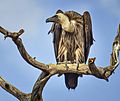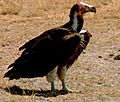Old World vulture facts for kids
Quick facts for kids Old World vultures
|
|
|---|---|
 |
|
| Lappet-faced vultures (left) and a white-backed vulture | |
| Scientific classification | |
| Kingdom: | Animalia |
| Phylum: | Chordata |
| Class: | Aves |
| Order: | Accipitriformes |
| Family: | Accipitridae |
| Groups included | |
|
|
Old World vultures are amazing birds found in Europe, Asia, and Africa. They are a type of vulture that belongs to the family Accipitridae. This family also includes other cool birds like eagles, buzzards, kites, and hawks.
Even though Old World vultures look a lot like New World vultures (found in the Americas), they are not closely related. Their similar looks are because they both adapted to eat the same way. This is called convergent evolution. It means different animals can develop similar features if they live in similar environments or have similar lifestyles. Old World vultures find their food only by sight.
All vultures are scavenging birds. This means they mostly eat dead animals. Many vultures have a head with very few feathers, or just soft down. For a long time, people thought this was so their feathers wouldn't get messy with blood and decaying meat. But new studies show it helps them stay cool! It's like a built-in air conditioner for their heads.
Contents
Types of Old World Vultures
Scientists group Old World vultures into two main subfamilies: Gypaetinae and Gypinae. These groups help us understand their family tree better.
Species of Old World Vultures
Here are some of the different kinds of Old World vultures:
| Subfamily | Genus | Common and binomial names | Image | Where They Live |
|---|---|---|---|---|
| Gypaetinae | Gypaetus | Bearded vulture Gypaetus barbatus |
 |
High mountains in southern Europe, the Caucasus, Africa, the Indian subcontinent and Tibet |
| Gypohierax | Palm-nut vulture Gypohierax angolensis |
 |
Forests and savannahs across sub-Saharan Africa | |
| Neophron | Egyptian vulture Neophron percnopterus |
 |
Southwestern Europe and North Africa to India | |
| Gypinae | Aegypius | Cinereous vulture Aegypius monachus |
 |
Southwestern and central Europe, Turkey, the central Middle East, northern India and central and eastern Asia |
| †Aegypius jinniushanensis | Formerly China | |||
| †Aegypius prepyrenaicus | Formerly Spain | |||
| Gyps | Griffon vulture Gyps fulvus |
 |
Mountains in southern Europe, North Africa and Asia | |
| White-rumped vulture Gyps bengalensis |
 |
Northern and central India, Pakistan, Nepal, Bangladesh and Southeast Asia | ||
| Rüppell's vulture Gyps rueppelli |
 |
The Sahel region of Central Africa | ||
| Indian vulture Gyps indicus |
 |
Central and peninsular India | ||
| Slender-billed vulture Gyps tenuirostris |
 |
The Sub-Himalayan regions of India and into Southeast Asia | ||
| Himalayan vulture Gyps himalayensis |
 |
The Himalayas and the Tibetan Plateau | ||
| White-backed vulture Gyps africanus |
 |
Savannahs of West and East Africa | ||
| Cape vulture Gyps coprotheres |
 |
Southern Africa | ||
| Necrosyrtes | Hooded vulture Necrosyrtes monachus |
 |
Sub-Saharan Africa | |
| Sarcogyps | Red-headed vulture Sarcogyps calvus |
 |
The Indian Subcontinent, with small populations in Southeast Asia | |
| Torgos | Lappet-faced vulture Torgos tracheliotos |
 |
Sub-Saharan Africa, the Sinai and Negev deserts and northwestern Saudi Arabia | |
| Trigonoceps | White-headed vulture Trigonoceps occipitalis |
 |
Sub-Saharan Africa | |
| †Neogyps |
† = extinct
Why Vulture Populations Are Declining
More than half of the Old World vulture species are in danger. They are listed as vulnerable, endangered, or critically endangered by the IUCN Red List. This means their numbers are dropping fast. Vultures are very important for the environment because they clean up dead animals. When their populations drop, it can cause problems for people's health and the environment.
Vultures often eat in big groups. This makes them very vulnerable to mass poisoning events. If one poisoned animal is found, many vultures can be affected at once.
Major Threats to Vultures
Harmful Medicines
A medicine called diclofenac has caused huge problems for vultures in India and Pakistan. Vulture populations there have dropped by as much as 99%! This medicine was given to farm animals to help with pain. But when these animals died, the diclofenac stayed in their bodies. Vultures would eat the carcasses and then get very sick, leading to kidney failure and death. Even a small amount of this drug can harm vultures.
Luckily, another medicine called Meloxicam has been found to be safe for vultures. Countries like Pakistan and Nepal have banned diclofenac for animals. India also banned it, but it can still be a problem in some areas.
Poisoned Carcasses
In Africa, many vultures die from poisoned carcasses. Sometimes, people who hunt animals illegally (poachers) poison dead animals. They do this to kill vultures. Why? Because vultures circling above a dead animal can alert park rangers to the illegal hunting. This is a big problem, especially with the demand for ivory.
Farm Poisons
Vultures can also be accidentally poisoned by farmers. Farmers sometimes use illegal pesticides to kill predators that threaten their livestock. If a predator eats the poison and then dies, vultures might eat its body and get poisoned too. These poisons are often cheap and easy to use, making them a common threat.
Traditional Uses
Vultures are sometimes killed for use in traditional medicine in Africa. People believe that certain parts of vultures can bring good luck or help with illnesses. For example, some believe vulture heads can help with clairvoyance (seeing the future). This demand for vulture parts is a serious threat to their survival.
Electrical Dangers
Vultures can also get hurt or die by flying into power lines or other electrical equipment. About 9% of vulture deaths in Africa are caused by collisions with electrical infrastructure. Some groups are working with power companies to make these structures safer for birds.
Why Vultures Are So Important
Vultures play a vital role in keeping ecosystems healthy. They are nature's cleanup crew! When their populations decline, it can lead to big problems:
- Hygiene: Without vultures, dead animals rot in the open. This can attract rats and feral dogs.
- Disease: More rats and dogs can lead to more diseases, like Rabies, which is a serious health threat to humans. India has a very high number of rabies cases.
Helping Vultures Survive
Many people and organizations are working hard to protect vultures.
- Protected Areas: Conservation efforts are most effective in large, protected areas where vultures can live safely.
- Stopping Poisoning: It's very important to stop poisoning events. Even small, frequent poisonings can harm vulture populations more than big, rare ones. Training park officials to find and neutralize poisoned carcasses quickly is key.
- Vulture Restaurants: In Nepal, there's a cool project called "Vulture Restaurant." It's a safe, open area where naturally dying or old cows are given to vultures to eat. This provides a safe food source free of harmful medicines.
- Policy Changes: Organizations are working to create and change laws to protect vultures at both national and international levels.
- Education: Campaigns are being launched to teach people about the dangers of poisoning and how important vultures are.
By working together, we can help these amazing birds survive and continue their important work in nature!

